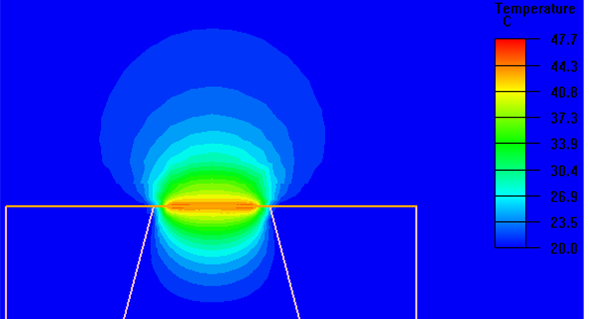| Line 57: | Line 57: | ||
==References== |
==References== |
||
| − | [1] T. Bechtold, D. |
+ | [1] T. Bechtold, D. Hohfeld, E. B. Rudnyi and M. Guenther, "Efficient extraction of thin-film thermal parameters from numerical models via parametric model order reduction," J. Micromech. Microeng. 20(2010) 045030 (13pp). |
[2] J. Spannhake, O. Schulz, A. Helwig, G. Müller and T. Doll,"Design, development and operational concept of an advanced MEMS IR source for miniaturized gas sensor systems ," Proc. Sensors, 762-765, 2005. |
[2] J. Spannhake, O. Schulz, A. Helwig, G. Müller and T. Doll,"Design, development and operational concept of an advanced MEMS IR source for miniaturized gas sensor systems ," Proc. Sensors, 762-765, 2005. |
||
Revision as of 08:51, 19 November 2012
Description of the model
A silicon nitride membrane (SiN membrane) [1] can be a part of a gas sensor, but also a part of an infra-red sensor, a michrothruster, an optimical filter etc. This structure resembles a microhotplate similar to other micro-fabricated devices such as gas sensors [2] and infrared sources [3]. See Fig.1, the temperature profile for the silicon nitride membrane.
The governing heat transfer equation in the membrane is:

where  is the thermal conductivity in
is the thermal conductivity in  , cp is the specific heat capacity in
, cp is the specific heat capacity in  ,
,  is the mass density in
is the mass density in  and
and  is the temperature distribution. We assume a homogeneous heat generation rate over a lumped resistor:
is the temperature distribution. We assume a homogeneous heat generation rate over a lumped resistor:

with  the heat generation rate per unit volume in
the heat generation rate per unit volume in  .
We use the initial condition
.
We use the initial condition  , and the
Dirichlet boundary condition
, and the
Dirichlet boundary condition  at the bottom of
the computational domain.
at the bottom of
the computational domain.
The convection boundary condition at the top of the membrane is

where  is the heat transfer coefficient between the membrane and the ambient air in
is the heat transfer coefficient between the membrane and the ambient air in  .
.
Discretization
Under the above convection boundary condition and assuming  , spatial discretization of the heat transfer model leads to the parametrized system as below,
, spatial discretization of the heat transfer model leads to the parametrized system as below,

where the volumetric heat capacity  , thermal conductivity
, thermal conductivity
 and the heat transfer coefficient
and the heat transfer coefficient  between the membrane
and the ambient air
between the membrane
and the ambient air  , are kept as parameters.
, are kept as parameters.
Here  is either a constant heat resistivity
is either a constant heat resistivity  , or
, or  , which depends linearly on the temperature. Here we use
, which depends linearly on the temperature. Here we use  and temperature coefficient
and temperature coefficient  . The model was created and meshed in ANSYS. It contains a constant load vector
. The model was created and meshed in ANSYS. It contains a constant load vector  corresponding to the constant input power of
corresponding to the constant input power of  . The number of degrees of freedom is
. The number of degrees of freedom is  .
.
The input function  is a step function with the value
is a step function with the value  , which disappears at the time
, which disappears at the time  . This means between
. This means between  and
and  input is one and after that it is zero. However, be aware that
input is one and after that it is zero. However, be aware that  is just a factor with which the load vector B is multiplied and which corresponds to the heating power of
is just a factor with which the load vector B is multiplied and which corresponds to the heating power of  . This means if one keeps
. This means if one keeps  as suggested above, the device is heated with
as suggested above, the device is heated with  for the time length of 0.02s and after that the heating is turned off. If for whatever reason, one wants the heating power to be
for the time length of 0.02s and after that the heating is turned off. If for whatever reason, one wants the heating power to be  , then
, then  has to be set equal to two, etc...
When
has to be set equal to two, etc...
When  , it is a function of the state vector
, it is a function of the state vector  and hence, the system has non-linear input. (It is also called a weakly nonlinear system.)
and hence, the system has non-linear input. (It is also called a weakly nonlinear system.)
Data information
The system matrices are in MatrixMarket format (http://math.nist.gov/MatrixMarket/) and can be downloaded here File:Matrices gassensor.tgz. The files named by *. correspond to the system matrices
correspond to the system matrices  , respectively. The files named by
, respectively. The files named by  correspond to
correspond to  . The file named by
. The file named by  corresponds to the load vector
corresponds to the load vector  and the file named by
and the file named by  corresponds to the output matrix
corresponds to the output matrix  .
.
References
[1] T. Bechtold, D. Hohfeld, E. B. Rudnyi and M. Guenther, "Efficient extraction of thin-film thermal parameters from numerical models via parametric model order reduction," J. Micromech. Microeng. 20(2010) 045030 (13pp).
[2] J. Spannhake, O. Schulz, A. Helwig, G. Müller and T. Doll,"Design, development and operational concept of an advanced MEMS IR source for miniaturized gas sensor systems ," Proc. Sensors, 762-765, 2005.
[3] M. Graf, D. Barrettino, S. Taschini, C. Hagleitner, A. Hierlemann and H. Baltes, "Metal oxide-based monolithic complementary metal oxide semiconductor gas sensor microsystem," Anal. Chem., 76:4437-4445, 2004.
Contact information:
Tamara Bechtold (tamara.bechtold@imtek.uni-freiburg.de)

